
[ad_1]
Hitting the Motherlobe
Hitting The Motherlobe
Fans may have been waiting a long time to continue Raz’s journey, but within the Psychonauts’ fiction, only a handful of days have passed since Raz left summer camp. The 2017 PlayStation VR game Psychonauts in the Rhombus of Ruin centered on Raz’s mission to rescue the head of the Psychonauts, Truman Zanotto, from a secret undersea lab, but that title only covered the events of a single day. Psychonauts 2 picks up the story the very next morning as Raz arrives at the Psychonauts’ headquarters, The Motherlobe, for a debrief.
“You ride back to base, and you realize that Doctor Loboto, amateur dentist and hobbyist brain surgeon [and one of the antagonists from the original Psychonauts], probably couldn’t have hatched his scheme by himself,” says Double Fine studio head Tim Schafer. “He’s got a helper inside the Psychonauts, a mole inside the Psychonauts, and that’s where the plot of this game starts. Who is the mole? How are we going to find the mole?”

The Motherlobe is the headquarters for the Psychonauts; the space has seen better days
The Motherlobe is the nerve center for the Psychonauts. Dozens of professional-looking businesspeople mill about the lobby while a few psychics dash off to the Think Tank – a building wing that contains several Psychonaut offices. One agent meditates in a corner while others grab a bite in the official commissary, cleverly titled the Noodle Bowl. Meanwhile, Raz looks over a giant wall sculpture depicting important Psychonauts from yesteryear. The Motherlobe serves as the game’s hub. Raz will regularly return to this sprawling complex between missions, allowing him to hunt for hidden collectibles and purchase consumables, such as health pickups, from the Psychonauts’ shop.
“It was really important for us to feel like the world of the Psychonauts opened up to Raz,” says art director Lisette Titre-Montgommery. “We wanted to make it feel like a really open, explorative space rather than a narrow, dungeon corridor … You see that the Psychonauts spent all their money on the headquarters, but they couldn’t take care of the grounds, so you see unfinished areas and scaffolding up in parts. We used those deconstructed elements to help build pathing into areas so you’re jumping on scaffolding and there’s rebar sticking out that you can swing off.”
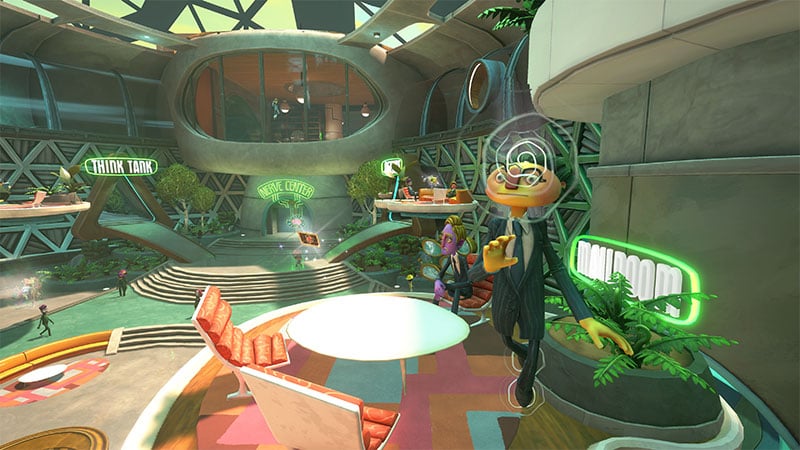
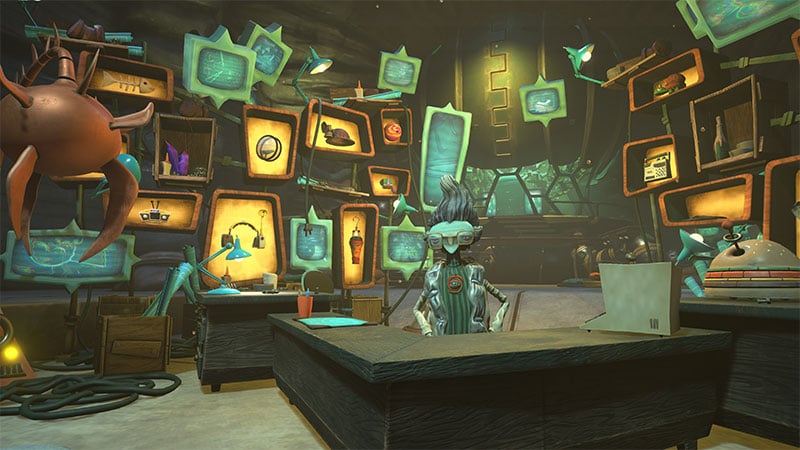
After the events of the first Psychonauts and Rhombus of Ruin, Raz feels like he’s proven himself, and he’s eager to hunt down the Psychonauts’ mole. Unfortunately, a few important Psychonauts don’t recognize Raz’s full capability. Hollis Forsythe, the second-in-command of the Psychonauts, is uncomfortable with letting Raz immediately jump into dangerous Psychonauts missions, and relegates him to the intern program. Raz has gone from saving the world to being on the lowest rung of the organization. Most of the other interns are all too eager to pick on the new kid to make matters worse.
“Hollis Forsythe has been running the Psychonauts since Truman Zanotto got kidnapped,” Schafer says. “She’s dealing with the financial problems they have. They’re less funded since they brought about world psychic peace, so people don’t think they need the Psychonauts anymore. She’s trying to hold it all together and deal with the fact that there’s this counterspy in the organization, so she’s very worried about the safety of the kids.”
As luck would have it, Raz will soon learn a new skill that could help him reverse his fortunes and prove himself to Hollis and the rest of his fellow interns – as long as he doesn’t accidentally dismantle the Psychonauts in the process.

Psychonauts’ art style was inspired by everything from filmmaker Tim Burton to the German Expressionism movement
Connecting The Dots
Connecting The Dots
As part of Raz’s internship training, Hollis instructs the young cadent in the ways of mental manipulation. This offers the perfect chance for Raz to brush up on his psychic abilities. Throughout the first Psychonauts, Raz learned several powerful mental skills, such as how to lift and throw objects around a room with Telekinesis, set things on fire with Pyrokinesis, and jump higher and glide through the air with Levitation. All of those powers return for the second game, and Raz will have access to them from the get-go. At any time, players can pull up a quick-select menu and assign up to four powers to their controller’s shoulder buttons.
Raz will also gain new abilities during this adventure, allowing him to become an even more powerful psychic master. Early on, Hollis teaches Raz an ability called Mental Connection, which enables him to link ideas together in a person’s mind. To demonstrate this skill, Hollis invites all the interns into her mind, where she has constructed a virtual classroom for lesson practice.

Inside Hollis’ mind, Raz notices a few thought bubbles, which float above the class as if they were clouds. He reaches out to one thought labeled “Delight.” Suddenly a beam of Mental Connection energy grabs the thought and pulls Raz up and into the thought bubble. Since Raz is a trained acrobat, many of his mental commands are manifested through physical, often acrobatic maneuvers. In this way, Mental Connection functions like a psychic grappling hook.
However, the full power of Mental Connection lies in connecting ideas. Using Mental Connection, Raz reaches for an idea labeled “Cilantro” and zips to it. A band of purple energy trails behind him, connecting the idea for Delight with the idea for Cilantro. “That’s pretty powerful,” Schafer remarks. He’s not wrong. As soon as Raz connects the two thoughts, Hollis’ mind begins to generate new thoughts, and Raz can use them as grapple points and climb out of Hollis’ psychic classroom. Before long, Raz has entered Hollis’ larger subconscious.

“Mental Connection is a fun power, because it’s both a really visceral physical power like a grapple hook – flying through the level really fast and kinetic – but it also has a strong narrative meaning since you’re actually changing thoughts,” Schafer says. “It is something that can handle lock and key type puzzles, or it can handle physical motion, and it’s useful in combat. We tried to make all the psychic powers fire on all those levels.”
Soon after, we see Raz put Mental Connection to the test in combat. Hollis’ subconscious notices Raz mucking around in her brain and sends a few Censors to stop him. Censors are some of the most common enemies in Psychonauts. These squat, bespectacled defenders try to stamp out any mental invaders, but Raz makes quick work of them with a few psi-blasts. Censors aren’t the only enemies Raz has to contend with; a new creature called Bad Idea also gives him trouble. These rabbit-eared, bug-eyed monsters can generate bombs on their back, which they toss around the room with reckless abandon. Not only do these bombs explode on contact, but Bad Ideas can drop bombs on the battlefield like landmines.


Most enemies are based off psychological fears or anxieties. Bad Ideas are a new enemy type that grow bombs on their back
“For the Bad Idea, we really wanted a range-based enemy that could throw bombs, and we were looking for a unique way to do that that wasn’t exactly like taking something out of your pocket and tossing it,” Titre-Montgommery says. “The design you see now is very close to the original sketch by [concept artist] Scott Campbell. He homed in on the fact that [the Bad Idea] was growing his own bombs on his back and spitting them out. We thought that was a really cool concept, having an enemy that can auto-generate its own explosives and also feel cute at the same time.”
Raz gets to work battling the Bad Idea with a series of close-quarters attacks, but some of Raz’s long-range mental powers are more effective. The Bad Idea lobs a few bombs, and Raz snatches one explosive from the air using Telekinesis. Raz returns the bomb, which stuns the monster, then uses Mental Connection to pull his enemy closer for one final psi-blast combo. Mental Connection is great for repositioning enemies on the field. However, when he uses Mental Connection on heavier enemies, Raz might be the one who ends up getting pulled across the room. Either way, Mental Connection is helpful for quickly closing the gap between foes.
“We want to have the psychic powers be more useful in battle,” Schafer says. “In the first game, you mostly just punched everything. In this game, every psychic power has some fun use in battle, and maybe an enemy who’s susceptible to it. There’s a lot more adapting your fight style to the enemies. In the first game, we put psychic powers in that people just forgot about, because you didn’t have to use them, so we’re trying to make it so all the psychic powers are useful all the time.”
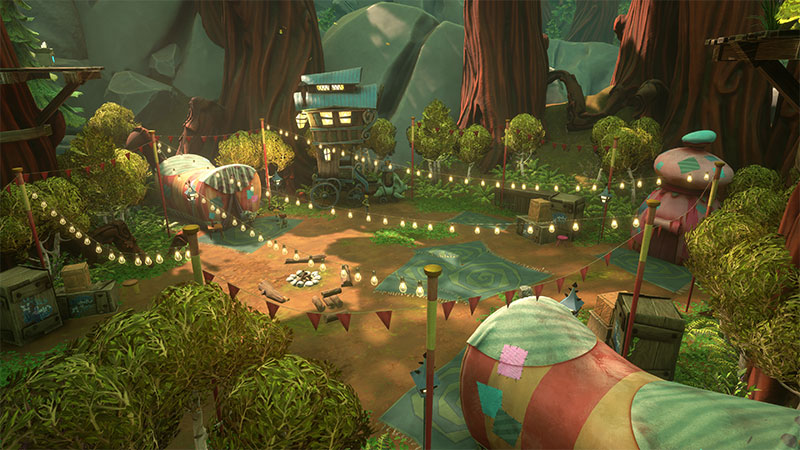
After defeating the Bad Idea, Raz continues to explore Hollis’ mind and learns more about his teacher along the way. Raz discovers that Hollis used to be a doctor. In fact, her mind is themed like a hospital. Raz walks through a morgue-like corridor then platforms across a few X-ray slides. Figments of wheelchairs and prescription drugs float in the background.
“In her medical school times, Hollis had a disreputable professor, Dr. Potts, who stole her work,” Schafer says. “She tried to use Mental Connection to make him not such an a-hole, and it actually ended up driving him a little – she went too far, and he had a big mental break. Truman Zanotto from the Psychonauts was called in to fix him, and that’s when Truman recruited [Hollis]. He was like, ‘You know, that was not great, but she’s obviously very skilled and powerful in the ways of Mental Connection.’”


After more exploration, Raz eventually stumbles into Hollis’ sanctuary, where she keeps some of her most strongly held beliefs. Overhead, Raz notices that the idea for Money is connected to the idea for Stress. Likewise, Death is linked to Risk. Raz reasons that if he can connect the idea for Risk to something other than Death, maybe Hollis won’t feel so uncomfortable with him joining the official mission to rout out the Psychonauts’ mole.
Raz uses his mental gymnastics to rewire Hollis’ mind, and we hear her reflect on these new connections. “Ugh. Why do some people think I want to see their socks out in public?” Hollis asks when Raz connects Disgust to the idea for Socks with Sandals. After a bit of platforming, Raz finally reaches the thought for Money and when he joins that with Risk, Hollis’ psyche begins to explode with new thoughts. Ideas like Proper Funding and Debt Relief appear. Hollis gets excited and her mind races with more new ideas, like Raises and New Programs. Raz changes Hollis’ mind just like he wanted, but he also set off a powerful chain reaction. There is nothing left to do now but run.
“Raz notices that things are starting to expand out of control in her brain as she realizes that risk could be the solution to all her money problems,” Schafer says. “It starts to form a bit of a monster in her mind.”

Brain Surgery
Brain Surgery
One of the unique things about Psychonauts is that every single level has a particular theme. As Raz jumps into the minds of different people across the campaign, players get introduced to wildly different gameplay concepts and design aesthetics. In the original Psychonauts, Raz spent time destroying a tiny city as a kaiju monster, played a miniatures war game against Napoleon Bonaparte, and snuck past a group of shadowy G-men in a topsy-turvy 1950s suburbia. Psychonauts 2 is no different, and the few glimpses we’ve seen to date show levels based on everything from dental care to 1960s psychedelic art.
“Every single level essentially had its own pre-production process,” Titre-Montgommery says. “Usually, a game has a pre-production phase, and then the studio moves to production, but because of the way our brain worlds work, we had to essentially start pre-production on every single brain over and over and over again. We needed each human brain to feel very different.”


The Psychonauts own a lot of space, and the outer grounds include a dense forest grove
Psychonauts 2’s wild tonal shifts keep the action fresh, but Double Fine’s adorable art design provides cohesion between each world. “We wanted to make sure that the art really reflected how dreamscapy and unrealistic and unpredictable the human mind is,” Titre-Montgommery says. “Psychonautical is a term we use because of how [that methodology] uses strong angles and shapes to disorient form, which helps you imagine dreamscapes. It breaks reality enough that you can buy into what we’re selling.”
Hollis’ mind is the second level in the game and Double Fine themed her mind around how ideas can change a person. Ever since Raz linked Money with Risk, Hollis has become obsessed with gambling. On the one hand, this benefits Raz. Hollis is willing to take more risks, so she allows Raz to join the Psychonauts’ official mission to hunt down the mole. On the other hand, Raz knows that he crossed a line and needs to put things back in order.
When Raz returns to Hollis’ mind, he discovers that it has completely transformed. Before, it was themed around her hospital background. Her mind still vaguely resembles a hospital, but now it is drenched in neon and full of Las Vegas trappings. Raz discovers that he can’t re-enter her mental sanctuary unless he completes three gambling-themed minigames and earns three gazillion dollars to become a “high-roller.”

Raz has officially joined the Psychonauts, but he’s been relegated to internship program, and his fellow interns like to make fun of him
As Raz completes his quests, he encounters a variety of collectibles. Like any good platformer, Psychonauts features a wild assortment of items for players to vacuum up. Classics from the first game return, such as the unfinished thoughts from people’s minds called figments. These are the most common collectible, but rarer treasures such as PSI Cards and PSI Cores allow Raz to expand his psychic abilities. Meanwhile, vaults unlock special narrative sequences that provide additional insight about the people Raz telepathically invades. At one point in our demo, Raz picks up a new collectible called Half-A-Mind, a little dancing brain in a top hat. When Raz collects two Half-A-Minds he’ll have a complete brain, which expands his health pool.
Another important collectible, called Nuggets of Wisdom, allows Raz to rank up. With each new level, Raz can upgrade his psychic abilities. When he improves his skills, they naturally become more powerful, but they may also gain new features. For example, if Raz upgrades his Pyrokinesis, his fire will burn hotter and last longer. If he upgrades his Psi Blast, he can charge the attack to unleash a larger explosion. And if he boosts his basic melee attack, he eventually learns a ground pound that produces a radiating shockwave that pushes enemies back.
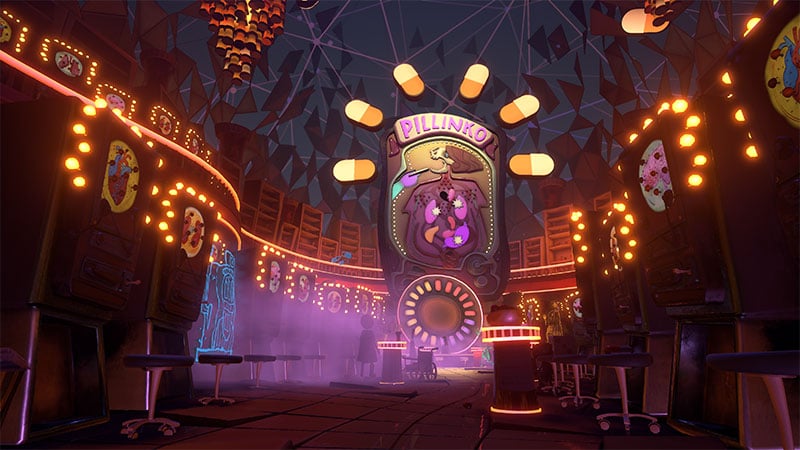

The Lady Luctopus Casino is a hotspot for anyone looking to gamble their life savings away
After working his way through the mental casino, Raz finally collects three gazillion dollars and is ready to re-enter Hollis’ mental sanctuary. Unfortunately, Hollis’ greed monster has now manifested as a lightbulb-studded octopus called Lady Luctopus. This boss fight takes place on top of a giant blackjack table, and Raz skillfully jumps across piles of poker chips as he dodges tentacles and a few ground attacks that electrify the floor.
Once Raz defeats Lady Luctopus, he restores Hollis’ mind to normal and saves her from financial ruin at the gambling tables. Unfortunately, the Psychonauts’ mission to uncover the mole wasn’t as successful. Not only did they fail to discover the identity of the spy, but the group found a few disturbing details about this mysterious force. This mole has been researching ancient necromantic rituals and seems to be planning to resurrect an ancient murderous evil that would threaten the safety of every psychic on the planet. But, you’ll have to wait until Psychonauts 2 hits later this year to learn more about that.
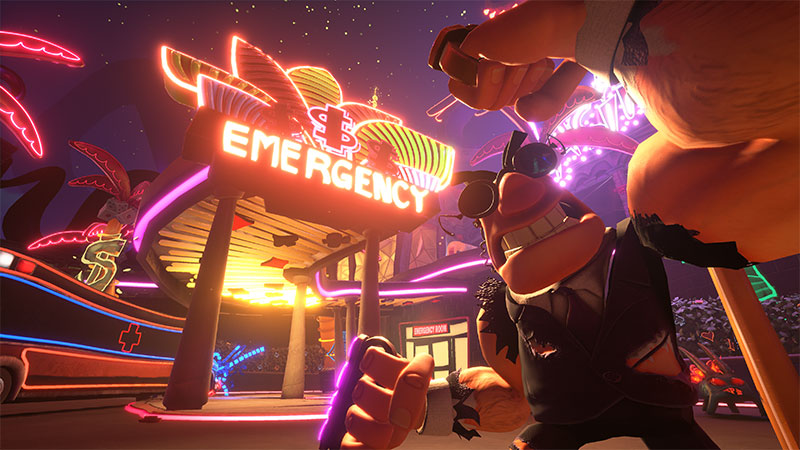
Censors are part of a mind’s natural defense system, and they try to stamp out dangerous or harmful thoughts. They also take several forms, such as these hulking Strongarm Censors
A Mind-Blowing Brain Game
A Mind-Blowing Brain Game
When Double Fine released the original Psychonauts in 2005, colorful 3D platformers were on the decline. These days the genre seems even less relevant, and few publishers outside of Nintendo even attempt games like this. But all that just goes to show how much of a passion project Psychonauts 2 is for the studio.
“The original Psychonauts will always be special,” Schafer says. “We always call it our flagship title, and we care about it a lot – we care about all the games that we’ve made, just that it’ll always be special in that way. I’ve always felt that we’re completely untied, untethered to anything. We always want our game to be surprising.”
Psychonauts 2 might not be the first in a new franchise, but when fans get their hands on the title they’re bound to be surprised. Double Fine has spent nearly six years packing Raz’s next journey full of exciting moments. Not only has the studio refined its platforming controls and dreamed up a host of wacky new worlds for players to explore, but the team has better integrated Raz’s superhuman powers into the game’s puzzles, exploration, and combat. Psychonauts 2 offers a rich narrative full of incredible psychic superpowers and lovable characters, but some players might discover even greater meaning at the heart of this story.

“In the first game, there are all these people that you would write off as villainous or weird or crazy, and then you go into their minds and you see what they’re struggling with, and you help them,” Schafer says. “We were in the recording studio and Khris Brown, our casting director, said, ‘You know, every level is like a different experience of healing.’ And it’s something that I wouldn’t have said was our purpose when I started the first game, but looking back on it, it seemed true … It’s weird to talk about Psychonauts as a mental health game, because it’s a comedy; it’s not a textbook in mental health or anything, but I feel like it has a good heart. It tries to get to the issue that we all have – these internal struggles – and you shouldn’t judge someone by how they behave on the outside because you never know what they’re struggling with inside.”
If Psychonauts 2 achieves anything half as noble as that, it will have been well worth the 16-year wait.
[ad_2]





